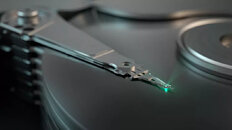Wednesday, October 28th 2020

Seagate: 20 TB HAMR Drives Arrive in December, 50 TB Capacities in 2026
In its latest earnings call, Seagate, a manufacturer of high-capacity drives, has revealed several interesting points about its upcoming releases of next-generation hard drives. More specifically, the company has disclosed a shift to a new generation of HDDs based on so-called heat-assisted magnetic recording (HAMR) technology. This technology is set to bring many improvements compared to the one currently used by Seagate's rivals like Western Digital. The rivaling company uses energy-assisted perpendicular magnetic recording (ePMR) and microwave-assisted (MAMR) technologies and it already has a 20 TB drive in the offering. Seagate announced that they will unveil a 20 TB HDD in December this year, with the use of HAMR technology, which will bring many improvements like better speed and more efficient disk read/write.
"We remain on track to ship 20-TB HAMR drives starting in December, which is an important milestone, as we believe HAMR technology will be the industry's path to scaling a real density and increasing drive capacities," said Dave Mosley, CEO of Seagate. "Seagate will be the first to ship this crucial technology with a path to deliver 50-TB HAMR drives forecast in 2026."
Source:
Seagate Earnings Call (Transcript)
"We remain on track to ship 20-TB HAMR drives starting in December, which is an important milestone, as we believe HAMR technology will be the industry's path to scaling a real density and increasing drive capacities," said Dave Mosley, CEO of Seagate. "Seagate will be the first to ship this crucial technology with a path to deliver 50-TB HAMR drives forecast in 2026."

60 Comments on Seagate: 20 TB HAMR Drives Arrive in December, 50 TB Capacities in 2026
Admittedly, I'm too lazy to look up Toshiba drives, since there seems to be way too many lineups...
Down below, the same table, just with the drives ordered according to their seek noise level.
There is also conflicting information regarding some Seagate drives. Some drives' datasheets inform noise levels of 18/20 db idle, but the user manual (which is what I used here) indicates 28/30. In those cases, I went with the worst case scenario.
I had a drive in my rig, and was playing a game when my mate paul came round. He said what is that noise, and it was my HDD. that was what made me decide to have no mechanicals in my new rig. I only have a 1TB m2 for boot/stuff and a 2TB m2 for games only, but i dont run out of space and it is fast and pretty quiet. If i need more space only sata ssd's but i would consider a big extenal mechanical under my desk.
But I do actually agree, HDDs are still the way to go if speed is mostly irrelevant, like for mass storage. But I bet within the decade SSDs will be so affordable HDDs go the way of the dodo.
Still, if noise is a concern, SSDs are unbeatable.